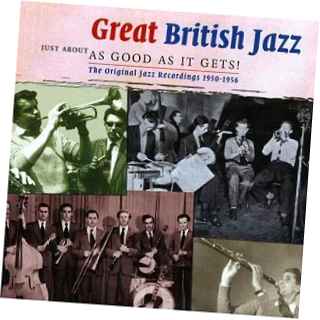
| Shake that thang | ||||||||||
JBP's jazz reviews
Page 6.
Great British Jazz.The Original Jazz Recordings 1950-56.
Smith & Co. Sound Division. SCCD 1143.
This double CD is not only enjoyable, it's a valuable historical document, and that should be twice celebrated because historical documents are rarely enjoyable.
So-called 'traditional jazz' is still alive and kicking in pubs, clubs and festivals in every region from Bude to Kirkcudbright, and as far as this collection is concerned must be defined as the jazz idioms of New Orleans and the white Chicago music known for some unreason as 'Dixieland.'
True jazz - based on co-operative improvisation and forming a strange four-way marriage between folk, ragtime, blues and African rhythms had its Golden Age in the 1920s, then experienced a strong revival of popularity in the 1940s. This popularity persisted through the 1950s when jazz first established itself widely and deeply in Britain.
In this country the 1930s was an era dominated by institutions known as 'dance bands' to which only the faintest traces of sub-jazz gave any sort of vitality. Young musicians who had learned jazz mainly from recordings of the American masters were often employed in these bands and had occasional opportunities to blaze forth. For example Nat Gonella, a trumpeter from the East End of London, was recognised as a player of immense talent, and allowed by orchestra leader Lew Stone to front a band-within-a-band, known as the Georgians. This unit became independent and well-known on radio and in clubs and theatres all over the country. Humphrey Lyttelton and Kenny Ball were among those influenced and inspired by Gonella.
In the 1950s when raw jazz grew popular enough to give life to a profusion of small outfits, the young jazz players were liberated into prodigies of joy and enthusiasm. I admit to a form of jazz snobbery at this time which caused me to collect 1920s American jazz, and to ignore the British bands. That idiocy has long been overcome, but the fact does increase my delight in hearing again the music of British bands played with remarkable skill, invention and energy by all these accomplished musicians. If you know the music this CD will bring back the spirit of the time, and may threaten you with the urge to jump up and down. If you don't know the music, try it. You may be astonished to find that an event which starts with mere foot-tapping can end with a form of euphoria. The best of luck.
Below is an alphabetical list of bands, identified by the leader's name:
Chris Barber
Eric Batty
Acker Bilk
Sandy Brown
Ken Colyer
Crane River Jazz band
Cy Laurie
Terry Lightfoot
Humphrey Lyttelton
Merseysippie Jazz band
Bobby Mickleburgh
Freddie Randall
Saints Jazz band
Eric Silk
Alex Welsh
and the Yorkshire Jazz band.I was particularly taken by the Saints, a species rarely encountered in jazz, and a unit I had never heard before.
![]()